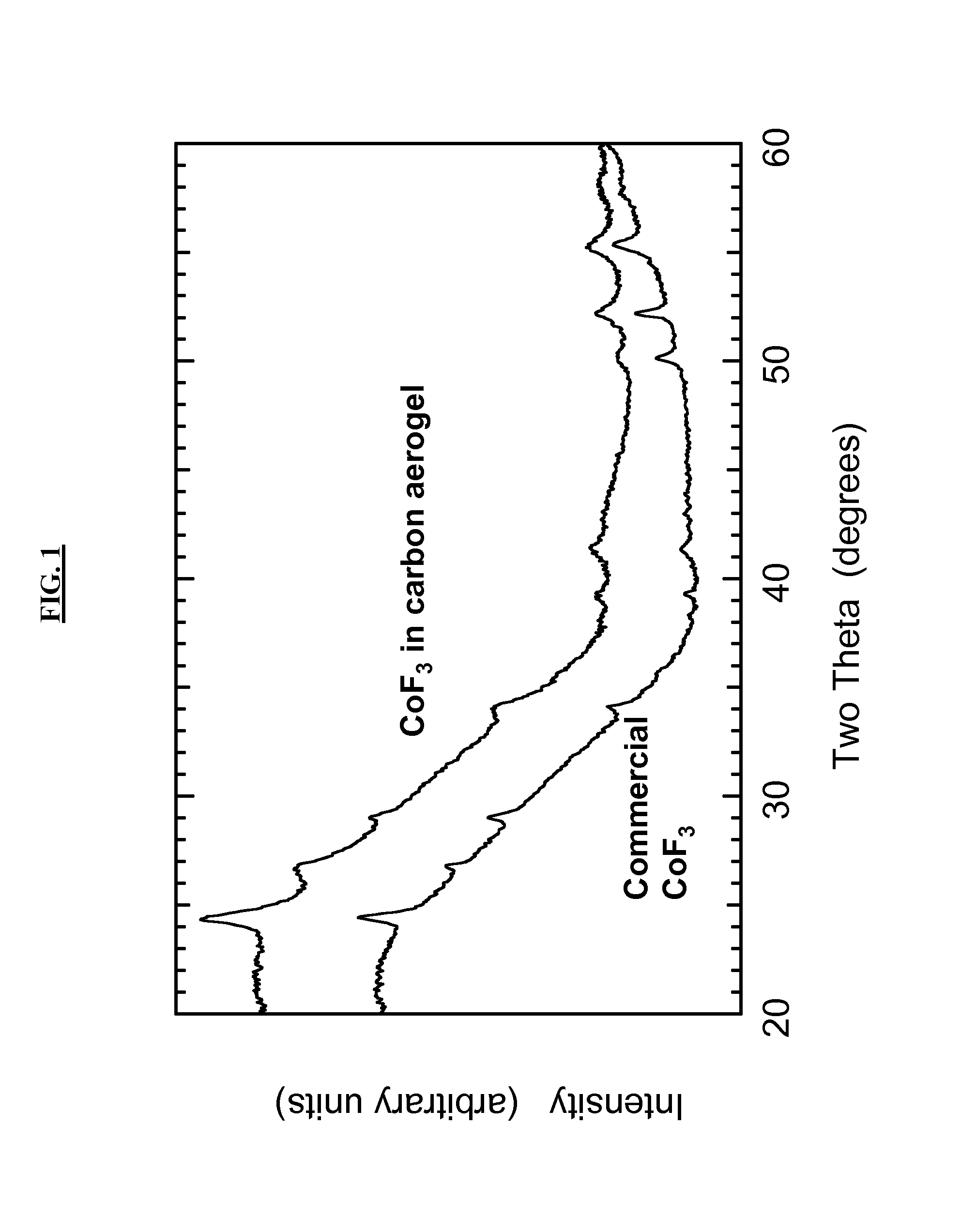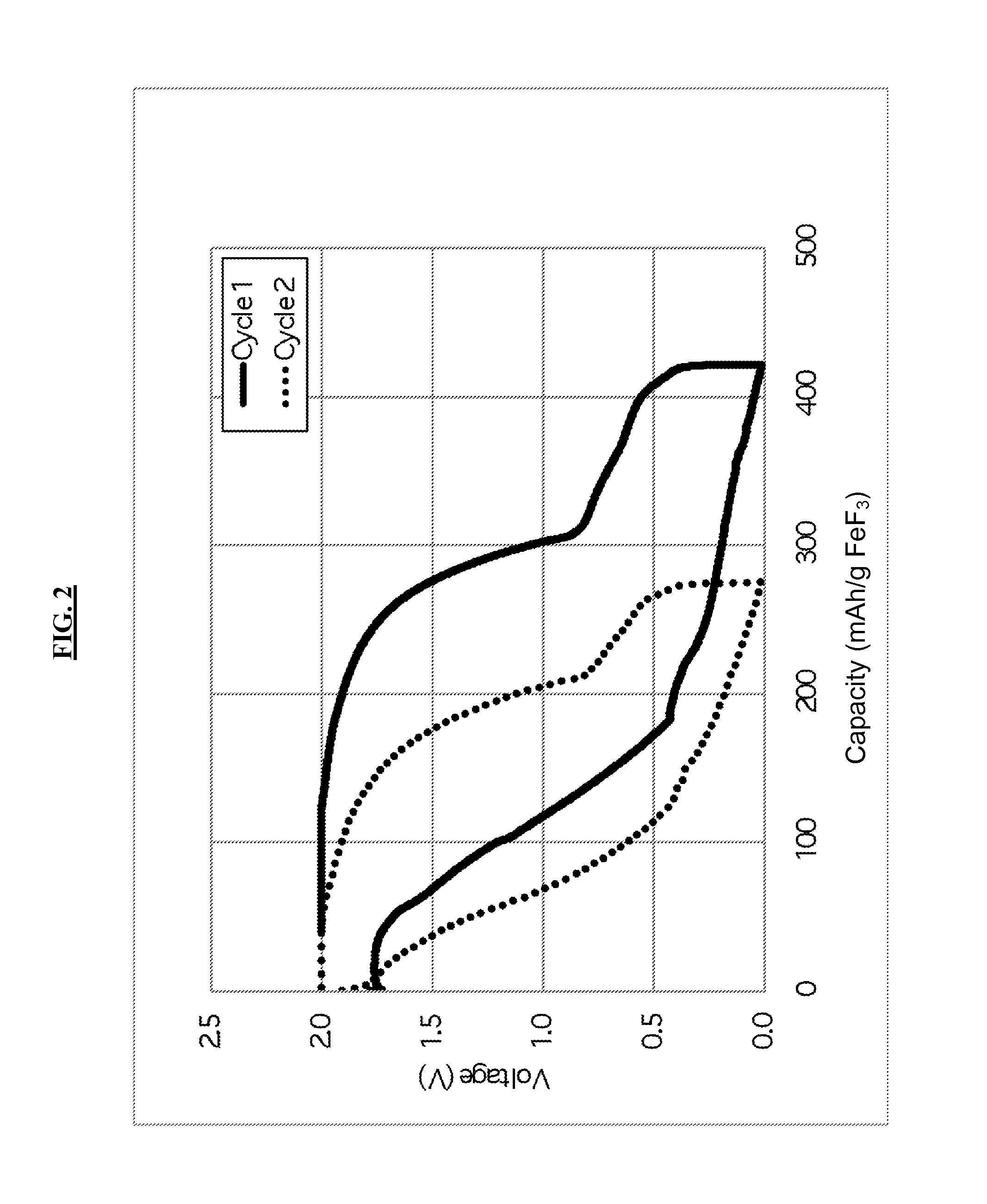Aluminum batteries comprising metal-oxide, metal-fluoride, metal-sulfide, or sulfur cathodes
a technology of aluminum batteries and cathodes, which is applied in the manufacture of electrodes, cell components, electrochemical generators, etc., can solve the problems of reducing the energy content of an al battery, persistent corrosion of anodes, and limiting storage li
- Summary
- Abstract
- Description
- Claims
- Application Information
AI Technical Summary
Benefits of technology
Problems solved by technology
Method used
Image
Examples
example 1
[0094]In this Example 1, CoF3 is incorporated into a nanostructure scaffold consisting of carbon aerogel with a peak in the pore-size distribution at 42 nm.
[0095]Carbon aerogel cubes (0.860 g) are placed in a flask and dried under vacuum while being heated to 300° C. for one hour. The aerogel is then cooled, backfilled with Ar, and kept in a sealed flask. Then 5.00 g of CoCl2.6H2O (Aldrich Chemical, 98 wt % purity) is placed in a glass vial and heated to 110° C. until melted. The aerogel is then removed from the flask and dropped into the molten CoCl2.6H2O. The vial containing the aerogel+CoCl2.6H2O mixture is sealed and placed back into a 110° C. oven for one hour to cause the cobalt chloride to wick into the aerogel pore volume by capillary force.
[0096]Next, the vial is removed from the oven and the CoCl2.6H2O-filled aerogel cubes are removed from the vial and placed in a Schlenk flask. The flask is first placed in an ice bath to solidify the CoCl2.6H2O and then vacuum is applied ...
example 2
[0100]An Al / FeF3 cell is constructed in a beaker using an Al foil anode. The electrolyte consists of 1-methyl-3-ethylimidazolium chloride (Aldrich, ≧95%) and AlCl3 (Aldrich, anhydrous, sublimed) in a 45:55 molar ratio. The cathode is formed by mechanically milling FeF3 (Aldrich, 98%) and carbon black (MMM Super P) at a 80 / 20 weight ratio in a Fritsch P6 planetary mill (80 cm3 hardened-steel milling vessel, 1.1 gram total sample weight, 30 Cr steel milling balls 7 mm in diameter, 400 rpm, 1 hour).
[0101]0.25 grams of this mixture are then mixed with 0.05 grams of TIMREX® KS6 graphite (Timcal AG) and 0.033 grams of poly(vinylidene fluoride-co-hexafluoropropylene) binder (Kynar Flex 2801) in 0.6 grams of 1-methyl-2-pyrrolidinone (NMP) to render a homogeneous slurry. The slurry is cast on carbon paper (Toray paper) and placed under an IR lamp for 2 hours to remove NMP solvent. Prior to coating, the carbon paper is sonicated in 0.5 M H2SO4 for 10 minutes to improve the adhesion of the FeF...
PUM
| Property | Measurement | Unit |
|---|---|---|
| particle size | aaaaa | aaaaa |
| electrical conductivity | aaaaa | aaaaa |
| pore diameter | aaaaa | aaaaa |
Abstract
Description
Claims
Application Information
 Login to View More
Login to View More - R&D
- Intellectual Property
- Life Sciences
- Materials
- Tech Scout
- Unparalleled Data Quality
- Higher Quality Content
- 60% Fewer Hallucinations
Browse by: Latest US Patents, China's latest patents, Technical Efficacy Thesaurus, Application Domain, Technology Topic, Popular Technical Reports.
© 2025 PatSnap. All rights reserved.Legal|Privacy policy|Modern Slavery Act Transparency Statement|Sitemap|About US| Contact US: help@patsnap.com



